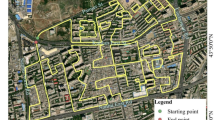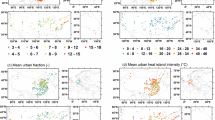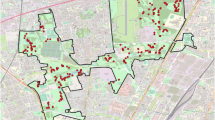Abstract
Sunlight exposure in urban areas is essential for human health, yet its reduction due to cloud cover and complex 3D urban architecture is often overlooked. Here we introduce a framework that combines natural day length variations, cloud cover and 3D urban structures to assess sunlight duration in cities. Applying this framework to 1,353 US cities, we found a significant decrease of 2,896 h (121 days) in available sunlight for 2020, with cloud cover accounting for 2,448 h (102 days) and urban structures contributing to a 448-h (19-day) loss. With the observed increasing trends in cloud cover and urbanization, sunlight loss is likely to worsen. Our study highlights the pressing need for interdisciplinary urban planning strategies that prioritize adequate access to natural sunlight.
This is a preview of subscription content, access via your institution
Access options
Subscribe to this journal
Receive 12 digital issues and online access to articles
118,99 € per year
only 9,92 € per issue
Buy this article
- Purchase on SpringerLink
- Instant access to full article PDF
Prices may be subject to local taxes which are calculated during checkout




Similar content being viewed by others
Data availability
Urban boundary of TIGER vector database is available at https://www.census.gov/tiger-data; WorldCover land cover product is available at https://esa-worldcover.org; GOES-16 clear sky mask product is available at https://www.goes-r.gov/spacesegment/abi.html; MOD09GA cloud mask product is available at https://developers.google.com/earth-engine/datasets/catalog/MODIS_061_MOD09GA; MYD09GA cloud mask product is available at https://developers.google.com/earth-engine/datasets/catalog/MODIS_061_MYD09GA; ISCCP HXG cloud mask product is available at https://gee-community-catalog.org/projects/isccp_hxg/; DSM data are available at https://planetarycomputer.microsoft.com/dataset/3dep-lidar-dsm; PlanetScope satellite data are available at https://www.planet.com/ under Planet Lab’s Education and Research license; NAIP aerial imagery is available at https://developers.google.com/earth-engine/datasets/catalog/USDA_NAIP_DOQQ; US Department of Energy’s BAP is available at https://atlas.eia.gov/datasets/eia::climate-zones-doe-building-america-program/; Daily Surface Weather and Climatological Summaries (Daymet) is available at https://developers.google.com/earth-engine/datasets/catalog/NASA_ORNL_DAYMET_V4.
Code availability
The script of the SVF calculation is available via GitHub at https://github.com/EarthObservation/RVT_py; the software of the natural solar duration time calculation is available at https://gml.noaa.gov/grad/solcalc/sunrise.html.
References
Gross, M. Light and Life (Oxford University Press, 2002).
De Souza, A. P. et al. Soybean photosynthesis and crop yield are improved by accelerating recovery from photoprotection. Science 377, 851–854 (2022).
Adole, T., Dash, J., Rodriguez-Galiano, V. & Atkinson, P. M. Photoperiod controls vegetation phenology across Africa. Communications Biology 2, 391 (2019).
Bouillon, R. Genetic and environmental determinants of vitamin D status. Lancet 376, 148–149 (2010).
Beute, F. & de Kort, Y. A. Salutogenic effects of the environment: review of health protective effects of nature and daylight. Appl. Psychol. Health Well-Being 6, 67–95 (2014).
Diffey, B. Do we need a revised public health policy on sun exposure? Br. J. Dermatol. 154, 1046–1051 (2006).
Neale, R. et al. The effects of exposure to solar radiation on human health. Photochem. Photobiol. Sci. 22, 1011–1047 (2023).
The Effect of Occupational Exposure to Solar Ultraviolet Radiation on Malignant Skin Melanoma and Non-melanoma Skin Cancer: A Systematic Review and Meta-analysis from the WHO/ILO Joint Estimates of the Work-Related Burden of Disease and Injury (World Health Organization, 2021).
Alfredsson, L. et al. Insufficient sun exposure has become a real public health problem. Int. J. Environ. Res. Public Health 17, 5014 (2020).
Lindqvist, P. G. et al. Avoidance of sun exposure as a risk factor for major causes of death: a competing risk analysis of the Melanoma in Southern Sweden cohort. J. Intern. Med. 280, 375–387 (2016).
Vitezova, A. et al. Vitamin D status and metabolic syndrome in the elderly: the Rotterdam Study. Eur. J. Endocrinol. 172, 327–335 (2015).
Bouillon, R. Vitamin D status in Africa is worse than in other continents. Lancet Glob. Health 8, e20–e21 (2020).
Mogire, R. M. et al. Prevalence of vitamin D deficiency in Africa: a systematic review and meta-analysis. Lancet Glob. Health 8, e134–e142 (2020).
Gu, S. et al. Exposure–lag-response association between sunlight and schizophrenia in Ningbo, China. Environ. Pollut. 247, 285–292 (2019).
Matuszko, D. Influence of cloudiness on sunshine duration. Int. J. Climatol. 32, 1527–1536 (2012).
He, Y., Wang, K., Zhou, C. & Wild, M. A revisit of global dimming and brightening based on the sunshine duration. Geophys. Res. Lett. 45, 4281–4289 (2018).
Almoudi, M. M., Hussein, A. S., Abu Hassan, M. I. & Schroth, R. J. Dental caries and vitamin D status in children in Asia. Pediatr. Int. 61, 327–338 (2019).
Zielinska-Dabkowska, K. M. & Xavia, K. Protect our right to light. Nature 568, 451–453 (2019).
Mahtta, R., Mahendra, A. & Seto, K. C. Building up or spreading out? Typologies of urban growth across 478 cities of 1 million+. Environ. Res. Lett. 14, 124077 (2019).
Wai, K.-M., Yu, P. K. & Lam, K.-S. Reduction of solar UV radiation due to urban high-rise buildings—a coupled modelling study. PLoS ONE 10, e0135562 (2015).
Wang, Y. et al. Exposure to sunlight reduces the risk of myopia in rhesus monkeys. PLoS ONE 10, e0127863 (2015).
Walker, W. H., Walton, J. C., DeVries, A. C. & Nelson, R. J. Circadian rhythm disruption and mental health. Transl. Psychiatry 10, 28 (2020).
Vo, T. T., Hu, L., Xue, L., Li, Q. & Chen, S. Urban effects on local cloud patterns. Proc. Natl Acad. Sci. USA 120, e2216765120 (2023).
Machete, R., Falcão, A. P., Gomes, M. G. & Rodrigues, A. M. The use of 3D GIS to analyse the influence of urban context on buildings’ solar energy potential. Energy Build. 177, 290–302 (2018).
Zhu, R., Zhang, F., Yan, J., Ratti, C. & Chen, M. A sustainable solar city: from utopia to reality facilitated by GIScience. Innov. Geosci. 1, 100006 (2023).
Lam, C. S. Y., Lam, C. H., Cheng, S. C. K. & Chan, L. Y. L. Prevalence of myopia among Hong Kong Chinese schoolchildren: changes over two decades. Ophthalm. Physiol. Opt. 32, 17–24 (2012).
Masson-Delmotte, V. et al. Global Warming of 1.5 °C: IPCC Special Report on Impacts of Global Warming of 1.5 °C above Pre-industrial Levels in Context of Strengthening Response to Climate Change, Sustainable Development, and Efforts to Eradicate Poverty (Cambridge Univ. Press, 2022).
United Nations. Transforming Our World: The 2030 Agenda for Sustainable Development (Division for Sustainable Development Goals, 2015).
Volf, C. et al. Why daylight should be a priority for urban planning. J. Urban Manag. 13, 175–182 (2024).
Nasrollahi, N. & Shokri, E. Daylight illuminance in urban environments for visual comfort and energy performance. Renew. Sustain. Energy Rev. 66, 861–874 (2016).
Lo Verso, V. R. M., Antonutto, G. & Torres, S. Sunlight–daylight signature: a novel concept to assess sunlight and daylight availability at urban scale. J. Daylight. 10, 136–152 (2023).
Turner, V. K., Middel, A. & Vanos, J. K. Shade is an essential solution for hotter cities. Nature 619, 694–697 (2023).
Chen, B., Lin, C., Gong, P. & An, J. Optimize urban shade using digital twins of cities. Nature 622, 242–242 (2023).
Calcabrini, A., Ziar, H., Isabella, O. & Zeman, M. A simplified skyline-based method for estimating the annual solar energy potential in urban environments. Nat. Energy 4, 206–215 (2019).
Zhang, Z. et al. Carbon mitigation potential afforded by rooftop photovoltaic in China. Nat. Commun. 14, 2347 (2023).
Wang, D. et al. A method for evaluating both shading and power generation effects of rooftop solar PV panels for different climate zones of China. Sol. Energy 205, 432–445 (2020).
Khan, A. & Santamouris, M. On the local warming potential of urban rooftop photovoltaic solar panels in cities. Sci. Rep. 13, 15623 (2023).
Zanaga, D. et al. ESA WorldCover 10 m 2021 v200. Zenodo https://zenodo.org/records/7254221 (2022).
Heidinger, A. Algorithm theoretical basis document ABI cloud height. NOAA NESDIS Center for Satellite Applications and Research http://www.goes-r.gov/products/ATBDs/baseline/Cloud_CldHeight_v2.0_no_color.pdf (2011).
Vermote, E., Kotchenova, S. & Ray, J. MODIS surface reflectance user’s guide. MODIS Land Surface Reflectance Science Computing Facility https://modis-land.gsfc.nasa.gov/pdf/MOD09_UserGuide_v1.4.pdf (2015).
Young, A. H., Knapp, K. R., Inamdar, A., Hankins, W. & Rossow, W. B. The International Satellite Cloud Climatology Project H-Series climate data record product. Earth Syst. Sci. Data 10, 583–593 (2018).
Houborg, R. & McCabe, M. F. A Cubesat Enabled Spatio-temporal Enhancement Method (CESTEM) utilizing Planet, Landsat and MODIS data. Remote Sens. Environ. 209, 211–226 (2018).
Li, X., Ratti, C. & Seiferling, I. Quantifying the shade provision of street trees in urban landscape: a case study in Boston, USA, using Google Street View. Landsc. Urban Plan. 169, 81–91 (2018).
Lee, K. & Levermore, G. J. Sky view factor and sunshine factor of urban geometry for urban heat island and renewable energy. Archit. Sci. Rev. 62, 26–34 (2019).
Meeus, J. H. Astronomical Algorithms (Willmann-Bell, 1991).
Gorelick, N. et al. Google Earth Engine: planetary-scale geospatial analysis for everyone. Remote Sens. Environ. 202, 18–27 (2017).
Jiménez, P. A. Assessment of the GOES-16 clear sky mask product over the contiguous USA using CALIPSO retrievals. Remote Sens. 12, 1630 (2020).
Sugarbaker, L. J. et al. The 3D Elevation Program Initiative: A Call for Action Report No. 2330-5703 (US Geological Survey, 2014).
Zakšek, K., Oštir, K. & Kokalj, Ž. Sky-view factor as a relief visualization technique. Remote Sens. 3, 398–415 (2011).
Tang, W., Qin, J., Yang, K., Jiang, Y. & Pan, W. Mapping long-term and high-resolution global gridded photosynthetically active radiation using the ISCCP H-series cloud product and reanalysis data. Earth Syst. Sci. Data 14, 2007–2019 (2022).
Wang, X. et al. No trends in spring and autumn phenology during the global warming hiatus. Nat. Commun. 10, 2389 (2019).
Acknowledgements
This study is supported by The University of Hong Kong HKU-100 Scholars Fund (to B.C.), Seed Fund for Strategic Interdisciplinary Research Scheme Fund (to B.C.) and Basic Research (to S.W. and B.C.), the Research Grants Council of Hong Kong Early Career Scheme (HKU27600222 to B.C.) and General Research Fund (HKU17601423 to B.C.), National Key Research and Development Program of China (2022YFB3903703 to B.C.), National Natural Science Foundation of China Young Scientists Fund (42201373 to B.C.), NSFC/RGC Joint Research Scheme (N_HKU722/23 to B.C.), the Croucher Foundation (CAS22902/CAS22HU01 to P.G.), the Major Program of the National Natural Science Foundation of China (42090015 to P.G.), the Research Grants Council of the Hong Kong Special Administration Region (T35/710/20R to C.L.), The University of Hong Kong Faculty of Business and Economics and Shenzhen Research Institutes (SZRI2023-CRF-04 to C.L.) and The University of Hong Kong Start-up Fund for New Professoriate Staff (to J.A.).
Author information
Authors and Affiliations
Contributions
B.C. conceived and designed the study. S.W. performed the main data analysis. S.W. and B.C. wrote the paper. J.A., C.L. and P.G. contributed to interpreting the results and reviewed and edited the paper.
Corresponding author
Ethics declarations
Competing interests
The authors declare no competing interests.
Peer review
Peer review information
Nature Cities thanks Marianne Berwick, Valerio Lo Verso, Richard Weller and Hesan Ziar for their contribution to the peer review of this work.
Additional information
Publisher’s note Springer Nature remains neutral with regard to jurisdictional claims in published maps and institutional affiliations.
Supplementary information
Supplementary Information
Supplementary Figs. 1–16 and Tables 1 and 2.
Rights and permissions
Springer Nature or its licensor (e.g. a society or other partner) holds exclusive rights to this article under a publishing agreement with the author(s) or other rightsholder(s); author self-archiving of the accepted manuscript version of this article is solely governed by the terms of such publishing agreement and applicable law.
About this article
Cite this article
Wu, S., Chen, B., An, J. et al. The interplay of cloud cover and 3D urban structures reduces human access to sunlight. Nat Cities 1, 686–694 (2024). https://doi.org/10.1038/s44284-024-00120-x
Received:
Accepted:
Published:
Issue Date:
DOI: https://doi.org/10.1038/s44284-024-00120-x
This article is cited by
-
Changes in the seasonality of cloud cover over China driven by El Niño − Southern Oscillation under global warming
Theoretical and Applied Climatology (2025)



